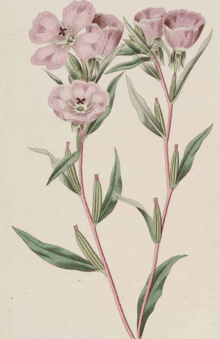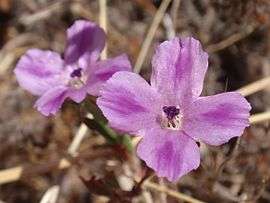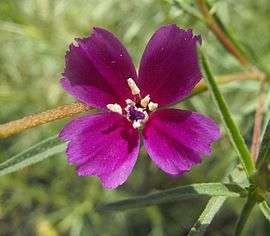Clarkia purpurea
Clarkia purpurea is a species of wildflower known by the common names winecup clarkia, winecup fairyfan, and purple clarkia.
| Clarkia purpurea | |
|---|---|
 | |
| Clarkia purpurea (artist:M. Hart) | |
| Scientific classification | |
| Kingdom: | Plantae |
| Clade: | Tracheophytes |
| Clade: | Angiosperms |
| Clade: | Eudicots |
| Clade: | Rosids |
| Order: | Myrtales |
| Family: | Onagraceae |
| Genus: | Clarkia |
| Species: | C. purpurea |
| Binomial name | |
| Clarkia purpurea | |


This annual plant is native to western North America, including: Baja California; California; Arizona; Oregon; Washington; and British Columbia. — where it is found in a diverse variety of habitats. In the California Floristic Province it is found in all the zones, except the deserts, from the coasts to high interior mountains, including the Sierra Nevada.[3][4]
Description
Clarkia purpurea erects a thin reddish stem which may approach 1 meter (3 ft.) in height and has a few lance-shaped leaves.[5]
The bowl-shaped flowers have four petals, usually one to two centimeters long. They are in shades of pink, purple, or deep wine red; often with a streak or spot of pink or red in the middle.[5]
Subspecies
Subspecies include:
Uses
The Indigenous peoples of California sowed the plant, to later harvest the seeds to grind for food.[5]
The conspicuous flowers support native bees, making it a "honey plant".[5]
Taxonomy
Clarkia purpurea was first described in 1796 as Oenothera purpurea in Curtis's Botanical Magazine.[9] In 1918, it was redescribed by Aven Nelson and James Francis Macbride, who allocated it to the genus Clarkia, as Clarkia purpurea.[9]
References
- IPNI: Clarkia purpurea. International Plant Name Index. Retrieved 27 November 2018.
- Nelson, A. & Macbride, J.F. (1918) Botanical Gazette 65: 64.
- Calflora database: Clarkia purpurea . 2.2.2013
- Jepson: distribution map .accessed 2.2.2013
- Lady Bird Johnson Wildflower Center Native Plant Information Network (NPIN): Clarkia purpurea (Winecup clarkia) . accessed 2.2.2013
- Calflora database: Clarkia purpurea ssp. purpurea
- Calflora database: Clarkia purpurea ssp. quadrivulnera
- Calflora database: Clarkia purpurea ssp. viminea
- Curtis, W. (1796) Curtis's Botanical Magazine 10: t. 352.
External links
| Wikimedia Commons has media related to Clarkia purpurea. |